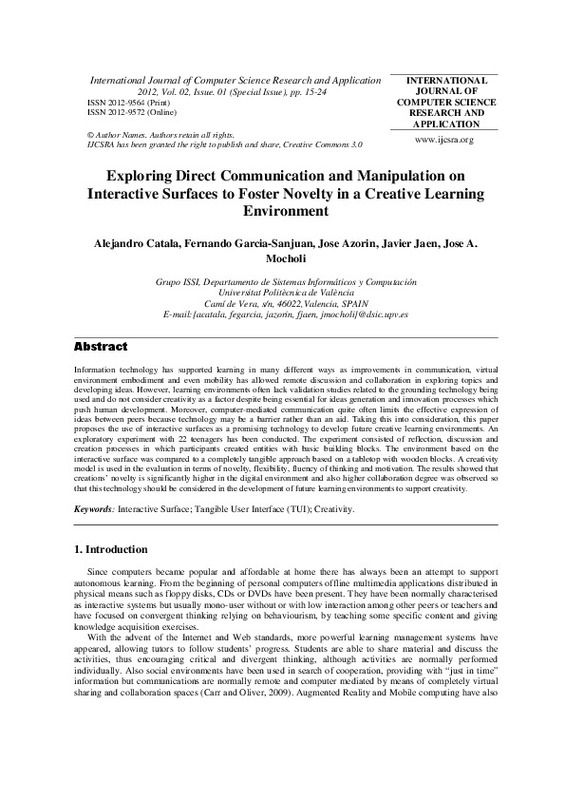JavaScript is disabled for your browser. Some features of this site may not work without it.
Buscar en RiuNet
Listar
Mi cuenta
Estadísticas
Ayuda RiuNet
Admin. UPV
Exploring Direct Communication and Manipulation on Interactive Surfaces to Foster Novelty in a Creative Learning Environment
Mostrar el registro sencillo del ítem
Ficheros en el ítem
| dc.contributor.author | Catalá Bolós, Alejandro
|
es_ES |
| dc.contributor.author | García Sanjuan, Fernando
|
es_ES |
| dc.contributor.author | Azorín Vicente, José Pascual
|
es_ES |
| dc.contributor.author | Jaén Martínez, Francisco Javier
|
es_ES |
| dc.contributor.author | Mocholí Agües, Jose Antonio
|
es_ES |
| dc.date.accessioned | 2014-01-29T12:51:15Z | |
| dc.date.available | 2014-01-29T12:51:15Z | |
| dc.date.issued | 2012 | |
| dc.identifier.issn | 2012-9564 | |
| dc.identifier.uri | http://hdl.handle.net/10251/35236 | |
| dc.description.abstract | [EN] Information technology has supported learning in many different ways as improvements in communication, virtual environment embodiment and even mobility has allowed remote discussion and collaboration in exploring topics and developing ideas. However, learning environments often lack validation studies related to the grounding technology being used and do not consider creativity as a factor despite being essential for ideas generation and innovation processes which push human development. Moreover, computer-mediated communication quite often limits the effective expression of ideas between peers because technology may be a barrier rather than an aid. Taking this into consideration, this paper proposes the use of interactive surfaces as a promising technology to develop future creative learning environments. An exploratory experiment with 22 teenagers has been conducted. The experiment consisted of reflection, discussion and creation processes in which participants created entities with basic building blocks. The environment based on the interactive surface was compared to a completely tangible approach based on a tabletop with wooden blocks. A creativity model is used in the evaluation in terms of novelty, flexibility and fluency of thinking and motivation. The results showed that creations' novelty is significantly higher in the digital environment and also higher collaboration degree was observed so that this technology should be considered in the development of future learning environments to support creativity. | es_ES |
| dc.description.sponsorship | This work was funded by the Spanish Ministry of Education under project TSI2010-20488. Our thanks to the Alaquas city council, the clubhouse’s managers, and also to Polimedia for the support in computer hardware. A. Catalá is supported by a FPU fellowship with reference AP2006-00181. | |
| dc.language | Inglés | es_ES |
| dc.publisher | INREWI Publications | es_ES |
| dc.relation.ispartof | International Journal of Computer Science Research and Application | es_ES |
| dc.rights | Reserva de todos los derechos | es_ES |
| dc.subject | Interactive Surface | es_ES |
| dc.subject | Tangible User Interface (TUI) | es_ES |
| dc.subject | Creativity | es_ES |
| dc.subject.classification | LENGUAJES Y SISTEMAS INFORMATICOS | es_ES |
| dc.title | Exploring Direct Communication and Manipulation on Interactive Surfaces to Foster Novelty in a Creative Learning Environment | es_ES |
| dc.type | Artículo | es_ES |
| dc.relation.projectID | info:eu-repo/grantAgreement/MICINN//TIN2010-20488/ES/CREATEWORLDS: UNA PLATAFORMA PARA EL APRENDIZAJE CREATIVO SOBRE MESAS INTERACTIVAS/ | es_ES |
| dc.relation.projectID | info:eu-repo/grantAgreement/MEC//AP2006-0018/ES/AP2006-0018/ | es_ES |
| dc.rights.accessRights | Abierto | es_ES |
| dc.contributor.affiliation | Universitat Politècnica de València. Departamento de Sistemas Informáticos y Computación - Departament de Sistemes Informàtics i Computació | es_ES |
| dc.description.bibliographicCitation | Catalá Bolós, A.; García Sanjuan, F.; Azorín Vicente, JP.; Jaén Martínez, FJ.; Mocholí Agües, JA. (2012). Exploring Direct Communication and Manipulation on Interactive Surfaces to Foster Novelty in a Creative Learning Environment. International Journal of Computer Science Research and Application. 2(1):15-24. http://hdl.handle.net/10251/35236 | es_ES |
| dc.description.accrualMethod | S | es_ES |
| dc.relation.publisherversion | https://sites.google.com/site/ijcsra/v2i1-acatala-et-el.pdf?attredirects=1 | es_ES |
| dc.description.upvformatpinicio | 15 | es_ES |
| dc.description.upvformatpfin | 24 | es_ES |
| dc.type.version | info:eu-repo/semantics/publishedVersion | es_ES |
| dc.description.volume | 2 | es_ES |
| dc.description.issue | 1 | es_ES |
| dc.relation.senia | 237123 | |
| dc.identifier.eissn | 2012-9572 | |
| dc.contributor.funder | Ministerio de Ciencia e Innovación | |
| dc.contributor.funder | Ministerio de Educación y Ciencia |






